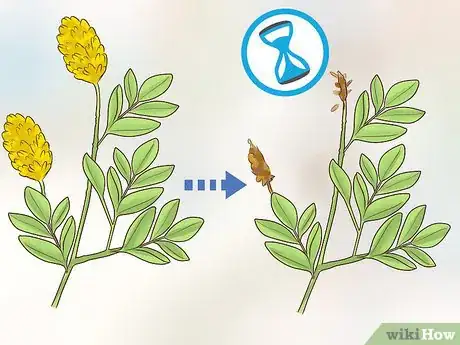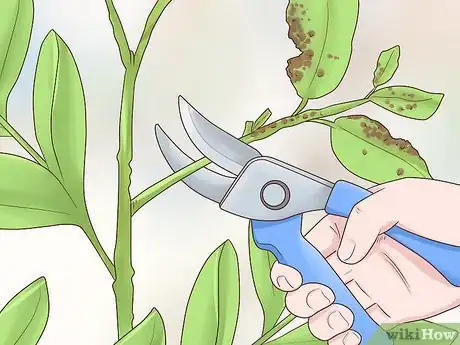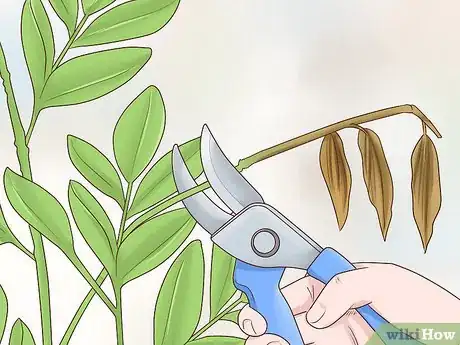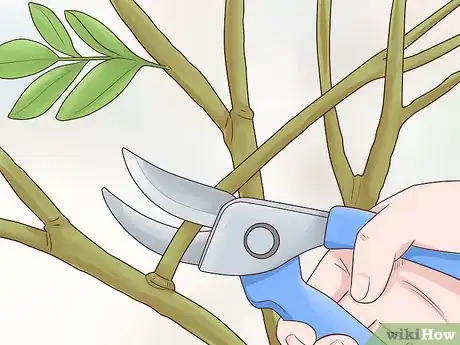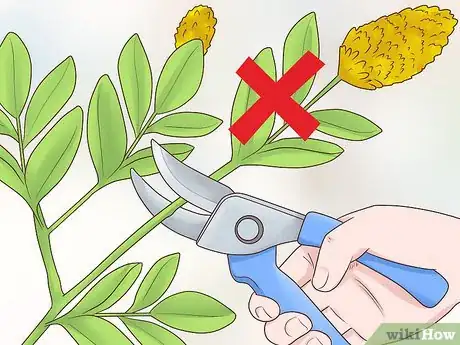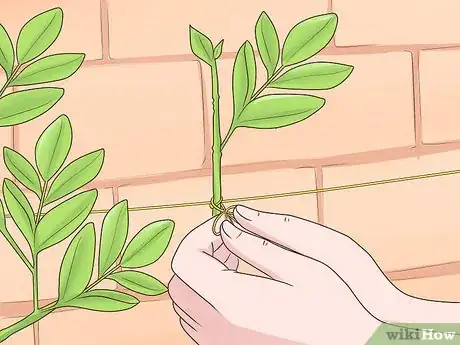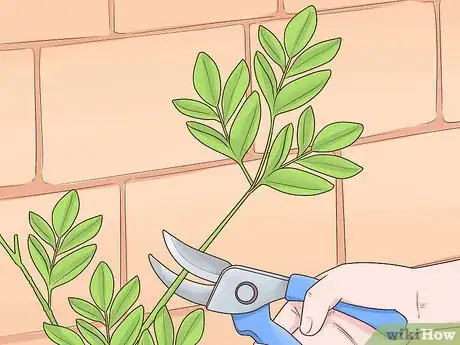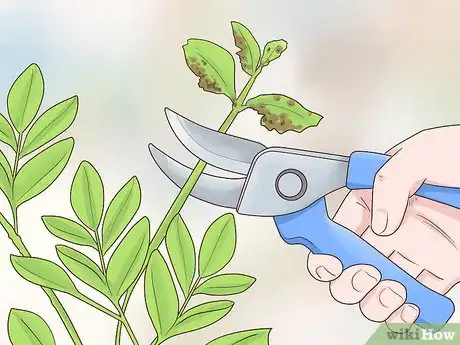This article was co-authored by Lauren Kurtz and by wikiHow staff writer, Kyle Hall. Lauren Kurtz is a Naturalist and Horticultural Specialist. Lauren has worked for Aurora, Colorado managing the Water-Wise Garden at Aurora Municipal Center for the Water Conservation Department. She earned a BA in Environmental and Sustainability Studies from Western Michigan University in 2014.
There are 7 references cited in this article, which can be found at the bottom of the page.
This article has been viewed 22,434 times.
Cytisus battandieri, also known as Pineapple Broom or Argyrocytisus battandieri, is a shrub that produces large yellow flowers in the summer that smell like pineapple. Pruning a Cytisus battandieri will help maintain its shape and encourage new and healthy flowers to bloom every summer. To successfully prune a Cytisus battandieri, you’ll want to focus on removing any dead or disruptive shoots from the shrub. You’ll also want to prune the shrub differently if it’s trained against a wall. By using sharp pruning shears and properly cutting back the shrub, you can help the Cytisus battandieri you’re pruning thrive year after year.
Steps
Pruning a Free-Standing Cytisus Battandieri
-
1Wait until after the shrub has finished flowering to prune it. Cytisus battandieri flowers during the summer, usually around mid-summer once it's warmer. Aim to prune the shrub around this time, after all the blooms have faded.[1]
- Pruning a Cytisus battandieri before it’s flowered could cause it to not flower properly.[2]
-
2Remove any diseased shoots from the shrub with pruning shears. Make sure the shears are sharp so you can make clean cuts. Inspect the shoots carefully to see if there’s anything out of place growing on them. If you find a fungus or growth on one of the shoots, use pruning shears to cut it off at the base of the shoot.[3]
- Remember to cut at the base of the shoot and not down by the roots. The base of the shoot is where the shoot branches off from the rest of the shrub.
- Always cut offshoots above any new buds forming at the base of the shoot.
- Honey fungus often affects Cytisus battandieri. Look for gold and brown mushroom caps growing on the shrub.[4]
Advertisement -
3Cut off any damaged or dead shoots. Damaged or dead shoots will look brown, wilted, and dry. Cut them off at the base of the shoot using the pruning shears.[5]
-
4Remove any unruly or crossing shoots to shape the shrub. If there are any shoots that are longer than the rest and stick out from the shrub, you can cut them back using the pruning shears. Use annual pruning as an opportunity to encourage the shrub to grow into a shape you like. Cytisus battandieri are often shaped to be fuller and rounder.[6]
-
5Add a fresh layer of mulch to the base of the shrub after pruning. Water the soil around the shrub until it is wet, and then spread a layer of mulch that is 2 inches (5 cm) to 3 inches (7.6 cm) thick. Use an organic mulch like wood chippings or compost. Organic mulches add beneficial nutrients to the soil.[7]
- You can find organic mulch at your local gardening center.
Pruning a Wall-Trained Cytisus Battandieri
-
1Avoid pruning a Cytisus battandieri until after it’s flowered. Pruning before flowering can result in the shrub not flowering properly. Cytisus battandieri flower during the summer, so wait until around mid-summer before you prune one, once all of the flowers have faded.[8]
-
2Tie in some new growth on the shrub to fill gaps in front of the wall. New growth on the shrub provides an opportunity to improve the appearance of the shrub against the wall, so take advantage of new shoots before you do any pruning. Pull in some of the new shoots and use garden twine to tie them to whatever the shrub is trained to the wall on, whether it’s wiring, a trellis, or a screen.[9]
- Be careful not to tie the new growth too tightly to the wall structure or you could damage the shoot.
- The shoots of the shrub should fan outward as they get higher up on the wall structure.
-
3Use pruning shears to cut back any shoots that have grown too long. Look for any shoots that are so long they disrupt the even, shaped appearance of the shrub. Cut them back to match the other shoots.[10]
- When cutting back the shoots, cut close to and above a bud, but avoid cutting into the bud itself.[11]
-
4Remove any dead or damaged shoots from the shrub. This includes any shoots that are broken, dried out, or shriveled up. Use the pruning shears to cut them off at the base.[12]
-
5Cut off any shoots that are growing toward the wall. Look through the gap in between the shrub and the wall to check for new shoots growing in the direction of the wall. Clip the wall-facing shoots with the pruning shears.[13]
-
6Lay down a layer of organic mulch at the base of the shrub. First water the shrub until the surrounding soil is wet. Make sure the layer of mulch is between 2 inches (5 cm) and 3 inches (7.6 cm) thick. You can use wood chippings, compost, or another type of organic mulch to add nutrients to the soil.
Community Q&A
-
QuestionWill it grow in a large tub?
 NinoxTop AnswererYes, but you have to plant it in a very large tub to avoid disrupting the roots.
NinoxTop AnswererYes, but you have to plant it in a very large tub to avoid disrupting the roots. -
QuestionIt flowered the best it ever has last year, but this year there's no leaves and only tiny grey shoots. No sign of life, but when I cut a branch from last year, it is green inside. No sign of disease. Any ideas?
 NinoxTop AnswererIf the branches are green inside, that means that the plant it still alive. Try to add fertilizer and ensure it has enough sun and water.
NinoxTop AnswererIf the branches are green inside, that means that the plant it still alive. Try to add fertilizer and ensure it has enough sun and water.
Things You’ll Need
- Pruning shears
- Mulch
References
- ↑ http://www.crocus.co.uk/features/_/articleid.977/
- ↑ http://www.telegraph.co.uk/gardening/6081754/Why-wont-my-flowering-shrubs-bloom.html
- ↑ https://www.rhs.org.uk/Plants/311000/Argyrocytisus-battandieri-Yellow-Tail/Details
- ↑ https://www.rhs.org.uk/Plants/311000/Argyrocytisus-battandieri-Yellow-Tail/Details
- ↑ http://www.crocus.co.uk/features/_/articleid.977/
- ↑ https://www.rhs.org.uk/advice/profile?pid=549
- ↑ https://www.rhs.org.uk/advice/profile?PID=323
- ↑ http://www.crocus.co.uk/features/_/articleid.977/
- ↑ https://www.rhs.org.uk/advice/profile?PID=379
